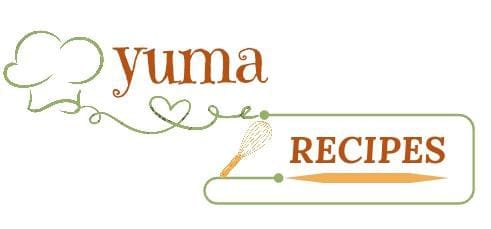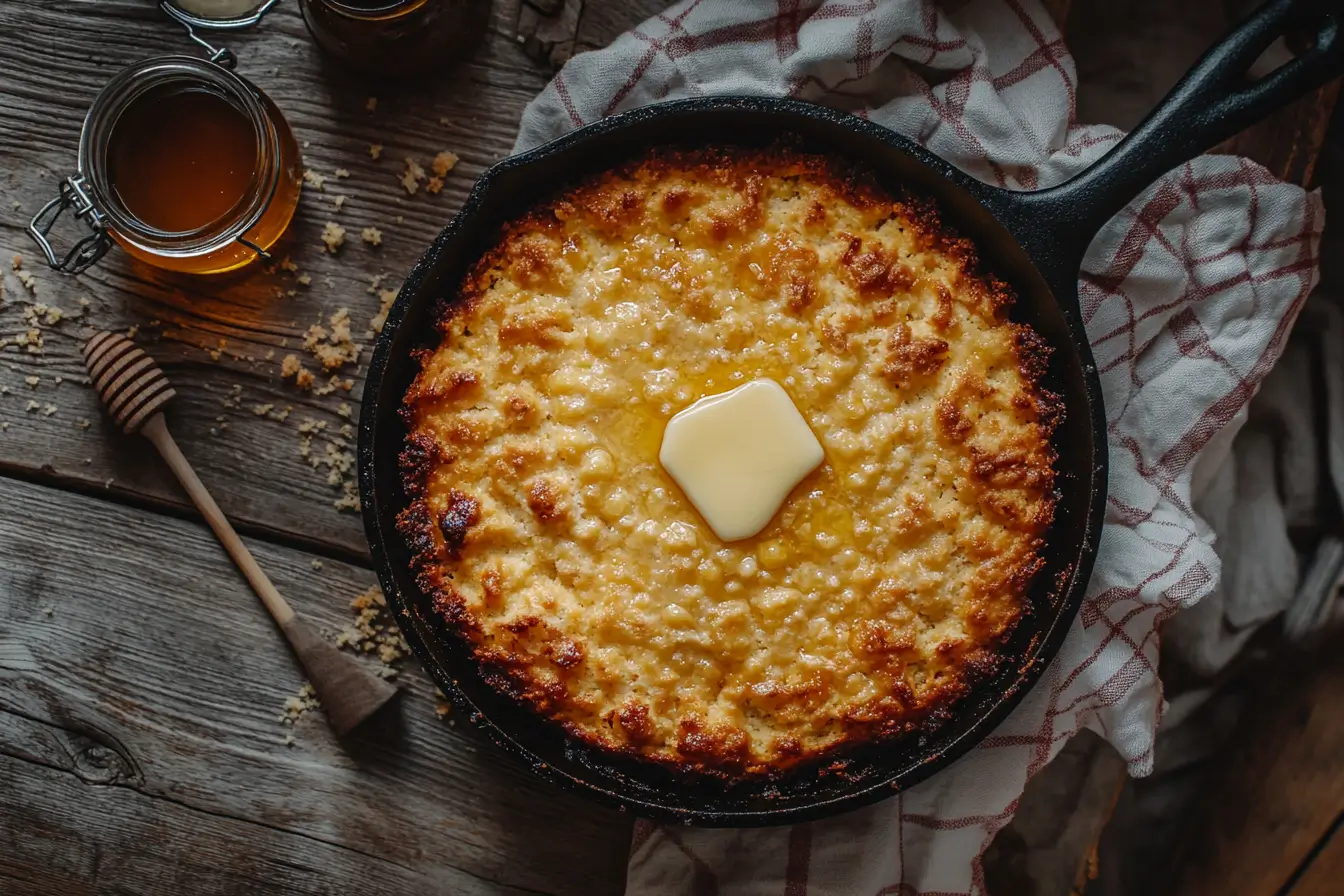Introduction
Cornbread has been a beloved staple in American cooking for centuries, and its appeal spans far beyond its humble ingredients. Whether you enjoy it as a side dish, a snack, or part of a hearty breakfast, cornbread is undeniably versatile. But when it comes to what is the difference between cornbread and Southern cornbread, the conversation heats up.
While both Northern and Southern styles share similar roots, their differences are significant enough to spark debates at family tables. Southern cornbread, in particular, stands out for its savory flavor, crumbly texture, and traditional preparation methods. In this article, we’ll take a closer look at what makes it unique, its history, its defining ingredients, and how it differs from its Northern counterpart. By the end, you’ll have all the knowledge (and perhaps a recipe or two) to create your perfect batch of cornbread.
Table of Contents
A Brief History of what is the difference between cornbread and Southern cornbread?
It originates from a time when corn was a staple crop in the South. Its ancestor, “corn pone,” was made with only cornmeal, salt, and water. Over time, ingredients like eggs and buttermilk were added to enhance flavor and texture. For more insight into traditional Southern ingredients, consider exploring dishes like the Ultimate Guide to Pumpkin Leaves.
When European settlers arrived, they embraced corn as a vital crop. Wheat was scarce in the South, so cornmeal became the go-to ingredient for bread-making. By adding buttermilk, bacon grease, and eggs, Southern cooks adapted the dish to suit their regional ingredients and culinary needs.
Over time, the Northern and Southern styles of cornbread evolved differently. Northern cornbread became sweeter, reflecting the abundance of sugar and wheat flour in the region. Meanwhile, Southern cornbread retained its savory and crumbly characteristics, aligning with the hearty, rustic meals of Southern cuisine. These regional differences are still evident today, which is why understanding what is the difference between cornbread and Southern cornbread is essential for any home cook.
What is the difference between cornbread and Southern cornbread?
Texture and Taste
When discussing the difference between cornbread and Southern cornbread, texture and taste are the most noticeable factors. It is crumbly, dense, and often savory. It complements dishes like chili, barbecue, or collard greens, acting as the perfect tool to soak up juices and gravies.
Northern cornbread, on the other hand, is sweeter and more cake-like. It’s often served as a standalone dish or paired with sweeter accompaniments like honey or jams. While Southern cornbread leans savory, Northern recipes emphasize sweetness, creating an entirely different flavor profile.
Ingredients
The ingredients used in Southern cornbread make it unique:
- Cornmeal as the Star: It primarily uses white cornmeal, which is finer and creates a crumbly texture. Northern cornbread often includes yellow cornmeal mixed with wheat flour, leading to a softer, less rustic result.
- Buttermilk and Bacon Grease: Buttermilk adds tanginess, while bacon grease provides a smoky flavor that’s quintessentially Southern.
- Sugar Debate: It traditionally avoids sugar, focusing on savory flavors. Northern cornbread often contains sugar or honey, adding a distinctly sweet taste.
Cooking Methods
Cooking techniques also highlight the difference. It is traditionally baked in a preheated cast iron skillet. The hot skillet ensures a crispy, golden crust that’s hard to replicate with other cookware. Northern cornbread, in contrast, is usually baked in pans, resulting in a softer and more uniform texture.
It is often savory and crumbly, made primarily with cornmeal and a minimal amount of flour. It typically avoids sugar, staying true to its role as a side dish for savory meals. This variety is traditionally baked in a cast iron skillet, which creates a crispy, golden crust that’s essential to its character.
The Ingredients That Define Southern Cornbread
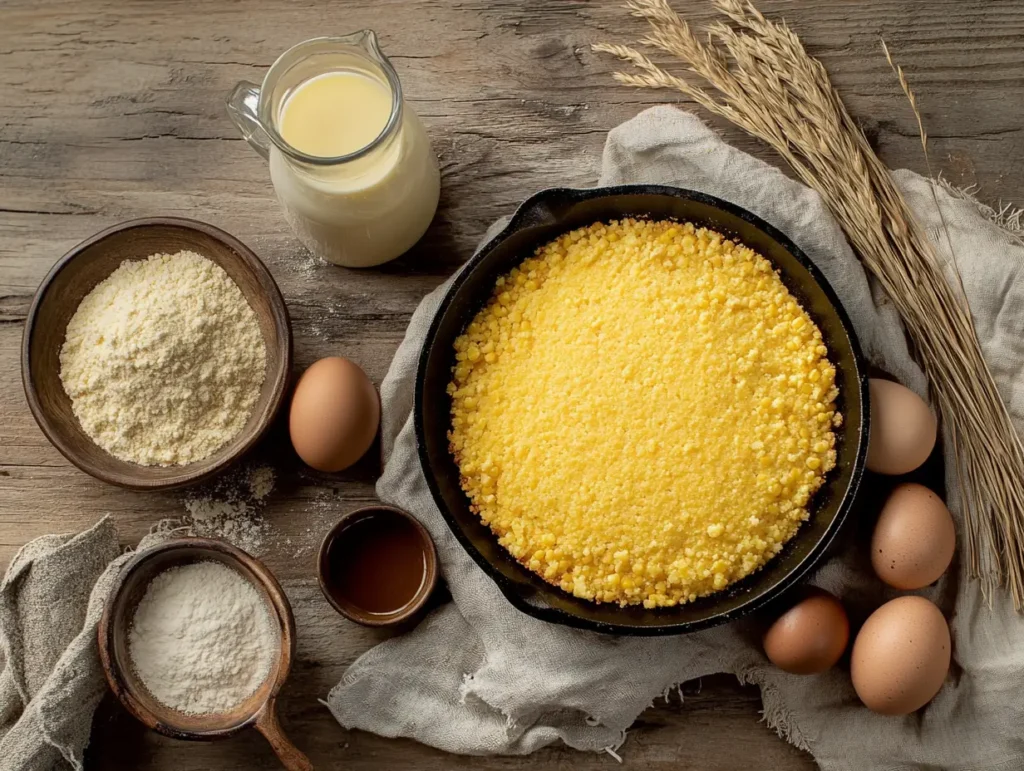
It relies on simple ingredients like cornmeal, buttermilk, and sometimes bacon grease, which gives it a distinct savory flavor. If you’re looking for a healthier twist, you might explore alternatives like the Ultimate Guide to Protein Cornbread, which introduces added nutritional value.
1. Yellow vs. White Cornmeal
The type of cornmeal used is critical in determining the texture and taste of cornbread. It favors white cornmeal for its finer grind and slightly milder flavor. This choice contributes to the bread’s crumbly texture, which is a hallmark of Southern cuisine.
Northern cornbread often opts for yellow cornmeal, which has a coarser texture and a more pronounced corn flavor. The addition of wheat flour in Northern recipes also makes the texture softer and more cake-like.
2. Buttermilk
Buttermilk plays a significant role in Southern cornbread recipes. Its acidity interacts with baking soda to create a light yet dense crumb. This tangy flavor complements savory dishes, making buttermilk a staple in authentic Southern cornbread.
3. Bacon Grease
One of the most distinctive ingredients in Southern cornbread is bacon grease. This flavorful fat not only enhances the bread’s taste but also helps create a crispy crust when baked in a cast iron skillet. Many traditional recipes rely on a mix of bacon grease and butter for the perfect balance of smokiness and richness.
4. Sugar or No Sugar?
The sugar debate is perhaps the most contentious aspect of what is the difference between cornbread and Southern cornbread. It purists argue that sugar has no place in cornbread, as its primary purpose is to accompany savory dishes. However, some modern Southern recipes include a small amount of sugar to balance the flavors.
Cooking Southern Cornbread the Right Way
The Role of a Cast Iron Skillet
The cast iron skillet is a cornerstone of Southern cooking traditions, and cornbread is no exception. Preheating the skillet before adding the batter is essential for achieving a crispy, golden crust. This method also ensures even cooking, which is crucial for the dense texture of Southern cornbread.
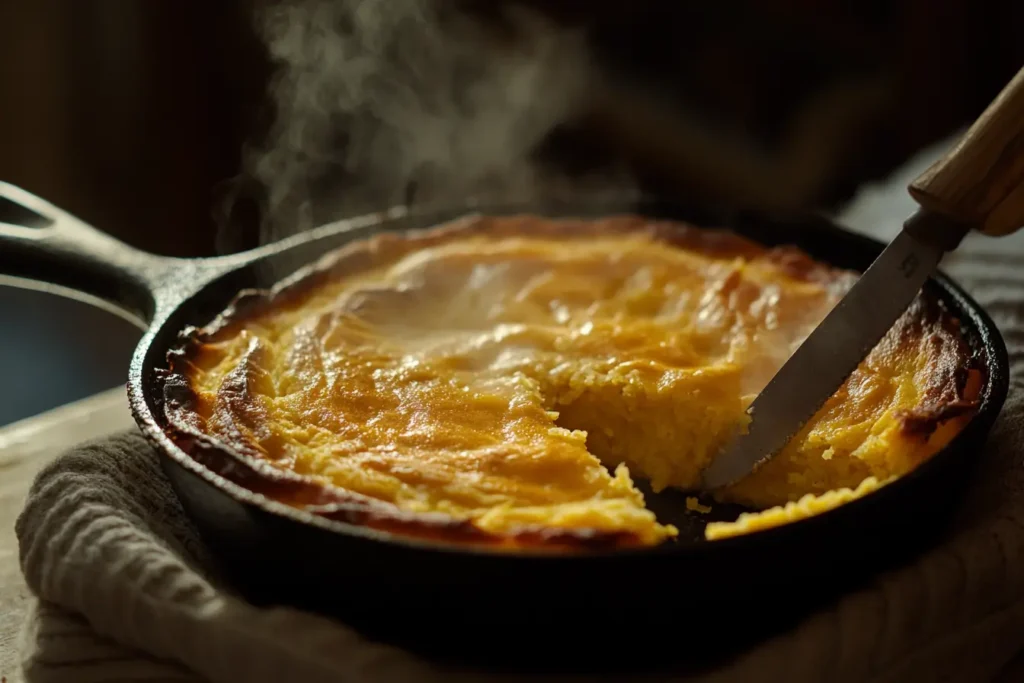
Tips for a Perfect Crust
- Grease the skillet generously with bacon grease or butter.
- Pour the batter into the hot skillet to create an instant sizzle.
- Bake at a high temperature to lock in moisture while forming a crust.
Leavening Agents: Baking Soda vs. Baking Powder
Most Southern recipes call for baking soda, which reacts with the acidity of buttermilk to produce the perfect rise. Baking powder can also be used, but it may alter the texture slightly, making it less dense.
What is the difference between cornbread and Southern cornbread?
It offers a sweeter, more dessert-like alternative to its Southern counterpart. It typically includes a mix of yellow cornmeal and wheat flour, giving it a softer texture. Sweeteners like sugar, honey, or molasses are common, creating a flavor profile that appeals to those with a sweet tooth.
Northern cornbread is often baked in pans, resulting in a uniform, cake-like texture. It’s perfect for serving with breakfast spreads or as a sweet side dish.
it shines as a sidekick to savory dishes like chili, barbecue, or collard greens. Its crumbly texture makes it perfect for soaking up hearty sauces.
For a contemporary twist, you might pair it with unique dishes such as Greek-Style Roasted Branzino for a fusion of flavors.
Popular Variations of Cornbread
Cornbread’s versatility means there’s a variation for every taste. Some of the most popular options include:
- Jalapeño Cornbread: Adds diced jalapeños for a spicy twist.
- Cheddar Cornbread: Incorporates shredded cheese for extra richness.
- Cornbread Muffins: Individual portions perfect for on-the-go meals.
- Honey Cornbread: Sweetened with natural honey for a subtle, floral flavor.
These variations demonstrate how cornbread can be adapted to suit different cuisines and preferences.
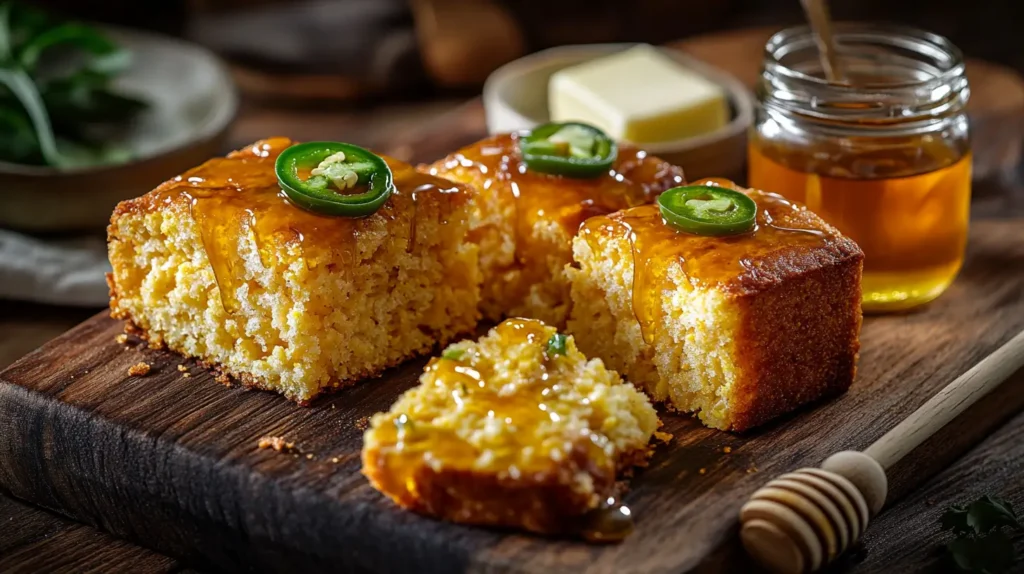
Cornbread in Southern Cuisine
It is more than just a side dish—it’s a cultural icon. It plays a central role in Southern meals, pairing perfectly with dishes like chili, collard greens, and fried chicken. During the holidays, it often appears in the form of cornbread dressing, a savory alternative to traditional stuffing.
The bread’s ability to soak up flavors makes it indispensable in Southern cuisine. Whether you’re serving it alongside a bowl of gumbo or using it to mop up barbecue sauce, Southern cornbread is as versatile as it is delicious.
Tips for Making the Perfect Southern Cornbread
- Choose high-quality white cornmeal for a finer texture.
- Always preheat your skillet to achieve a crispy crust.
- Adjust the sugar content to match your preferences—less is more for a traditional taste.
Storing and Using Leftovers
Storage Tips
- Wrap cornbread tightly in foil or plastic wrap to keep it moist.
- Store it in the refrigerator for up to five days or freeze it for longer periods.
Creative Uses for Leftovers
- Cornbread Stuffing: A holiday favorite.
- Croutons: Toasted cornbread cubes make excellent soup toppings.
- Casseroles: Use crumbled cornbread as a casserole topping for added texture.
FAQs about What is the difference between cornbread and Southern cornbread?
Why is Southern cornbread not sweet?
It is traditionally savory, designed to complement main dishes like greens, chili, or barbecue. The lack of sugar emphasizes its rustic and functional role in meals.
What is Southern cornbread called?
It is often simply called “cornbread” in the South. It’s known for its crumbly texture, savory flavor, and crispy crust achieved through skillet baking.
Is sweet cornbread from the North or South?
Sweet cornbread is typically associated with Northern cooking. The use of sugar, honey, or molasses in these recipes reflects the region’s preference for sweeter baked goods.
Does Southern cornbread have sugar?
Traditional Southern cornbread recipes usually exclude sugar. However, some modern variations include a small amount to balance the flavors.
Conclusion for What is the difference between cornbread and Southern cornbread?
While both Northern and Southern cornbreads share a common origin, their differences reflect the regional ingredients, tastes, and traditions that shaped them. Whether you prefer the savory crispiness of Southern cornbread or the sweet, cakey softness of its Northern cousin, both are integral to the diverse tapestry of American cuisine.
No matter which style you favor, understanding these distinctions enhances your appreciation of this beloved dish. Ready to try your hand at making authentic cornbread? Check out this Southern Cornbread Recipe for a taste of the South or explore more versatile options with the Ultimate Guide to Protein Cornbread.
